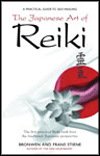Reiki meditations and techniques
Reiki meditations and techniques are one of the five main elements of the system of Reiki. The following two paragraphs are an excerpt from The Japanese Art of Reiki.
There are three major techniques taught in the first level of the system that lie at its foundation. The first of these is a cleansing technique called Kenyoku Hô. Following that is Jôshin Kokyû Hô: a meditation to focus the mind using breath and; finally, Seishin Toitsu: a unifying the mind meditation. These are taught in traditional forms of the system of Reiki.
The last is a meditation taught in the second level of the system called Hatsurei Hô. In modern times it is practiced simply as a combination of the three aforementioned techniques. Instead, an original version of Hatsurei Hô, written by a student of Usui called Tomita Kaiji in 1933, has been included here.
Source
Kokyû (breathing) techniques in Japan have been practiced namely in both religious and martial arts practices with Usui being a serious practitioner of both traditions. Martial arts practices such as Daito Ryu Jujitsu and aikidô advocate that practices based on kokyû bring about an awareness of the whole. Such awareness is the result of a unified body and body developed through kokyû.
After Usui’s death in 1926, a number of techniques were taught under the auspices of the system of Reiki. Some of these techniques made their way to America in the late 1930s while others did not.
Traditional Techniques
Hatsurei Ho
A method for generating greater amounts of spiritual energy.
Techniques of one kind or another have always been used in conjunction with the system of Reiki. Hatsurei-ho is one of the early techniques. We know this for certain as it exists in a 1933 book by Kaiji Tomita, a student of Usui Mikao. Below is a translation of this technique from that book which is much simpler than what is practised in Japan and the West today. The chanting of waka, poetry written by the Meiji Emperor, is not generally practised in the West.
hatsu – to generate
rei – spirit
ho – method
First sit down and try to concentrate (unify) the mind and body. Choose a quiet place or somewhere comfortable where you can relax. Included in the text are 2 different readings of the word seiza. One means to sit still and is the first part of the technique the other relates to the physical action of sitting in seiza.
1. Seiza (lit. Japanese) [to sit still]
Sit in the seiza position and gassho with the objective to gather/concentrate the energy from the heart into the palms of the hands. Hold the hands together without using force from the arms or the shoulders. Drop the shoulders and clasp the hands, joining the fingers lightly and feel the alignment of the posture. Close your eyes.
2. Joshin ho (Mind purification method)
The aim of Joshin-ho is to unify and purify the mind. Once the sitting upright is achieved, recite (in your head) some waka poetry and feel at One with its meaning.
Here is an example of the Meiji Emperor’s waka [[find out more about waka here Reiki Poetry]] waka is a form of poem used by Usui Mikao that can be used for joshin ho.
Asamidori sumiwataritaru ohzorano
hiroki onoga kokoro to moganaAs a great sky in clear light green
I wish my heart would be as vast.
3. Hatsurei Ho
If you have followed the previous steps and stayed focused on the palms of your hands they start to become warm. This is what Tomita ryu calls reiha (wave of rei). It describes the tingling sensation that is comparable to an electrical current. The heat created and the wave of rei are what constitute spiritual energy. Even if the sensations are weak at first, they should become stronger as you keep concentrating.
4. 5 Day plan
Repeat the above steps for 5 consecutive days, and concentrate for at least 30 minutes (progressively increasing eventually reaching an hour).
To support students in traditional practices the International House of Reiki offers the Reiki Ho CD to guide practitioners on a 30 minute practise of Hatsurei Ho plus a fifteen minute explanation abotut its use in the system of Reiki. You can buy it here.
Kenyoku Ho
Kenyoku Hô is a Japanese Shinto practise that purifies the body, heart and spirit. It is generally used before and after the practice of any energy work. On each out breath the hands sweep across the body, as if you are washing yourself clean.
- Sweep with your right hand from your left shoulder down and across to your right hip.
- Sweep with your left hand from your right shoulder down and across to your left hip.
- Sweep with your right hand from your left shoulder down and across to your right hip.
- With your left elbow against your side and your left forearm horizontal to the ground, sweep with your right hand from your left shoulder down the arm and out along the upturned palm to the fingertips.
- With your right elbow against your side and your right forearm horizontal to the ground, sweep with your left hand from your right shoulder down the arm and out along the upturned palm to the fingertips.
- With your left elbow against your side and your left forearm horizontal to the ground, sweep with your right hand from your left shoulder down the arm and out along the upturned palm to the fingertips.
Kenyoku Ho Reiki Technique from International House of Reiki

